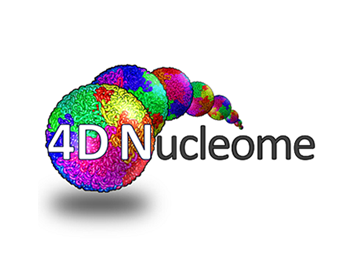
Under its new 4D Nucleome Program, the National Institutes of Health (NIH) Common Fund has awarded $12.5 million over five years to the Data Coordination and Integration Center (DCIC) hosted at DBMI.
The 4D Nucleome Program is aimed at better understanding how DNA is arranged within the three dimensional cell nucleus over time: cell cycle, development, and disease. The program encompasses 29 awards to 24 different institutions throughout the United States. The high-throughput data generated by all these centers will be collected, curated, and integrated by the DCIC.
The nucleus in each human cell, with an average diameter of 6 micrometres (µm), contains approximately 2 meters of DNA. It is now known that the folding of DNA inside the nucleus is tightly controlled. Furthermore, the organization of DNA in three dimensions has important roles in gene regulation. However, the mechanisms controlling the three-dimensional architecture of the nucleus and their contribution to gene expression regulation are not well understood. Recent advances in genomic assays and microscopy technologies provide new opportunities to shed light on these domains. The 4D Nucleome Program will both uncover the principles of nucleus organization and provide advances in mapping out time-dependent roles of all functional DNA elements.
The Data Coordination and Integration Center constitutes one of the six separate but related 4D Nucleome Project initiatives. The Center is led by Dr. Peter Park and is a collaboration between Park, Kharchenko, Gehlenborg labs at DBMI, Pfister lab at the Harvard Paulson School of Engineering and Applied Sciences, and Mirny Lab at MIT Physics Department.
The size of the data generated by the consortium, estimated at multiple peta-bytes will bring, along with the opportunity for discovery, its ample challenges. These challenges are not limited to data storage, processing, and transfer; but also include proper curation, search, and visualization to make the data accessible and useful to the community at large. DCIC is excited to bring together the expertise pertinent to tackling these challenges: Dr. Peter Kharchenko in genomic data integration and single-cell analysis, Dr. Nils Gehlenborg in data visualization and provenance, Mr. David Bernick in cloud architecture, Dr. Leonid Mirny in sequencing data analysis and 3D modeling, and Dr. Hanspeter Pfister in data visualization including 3D image reconstruction. Overseeing the operations of the 4DN-DCIC will be Burak Alver, Scientific Project Manager.